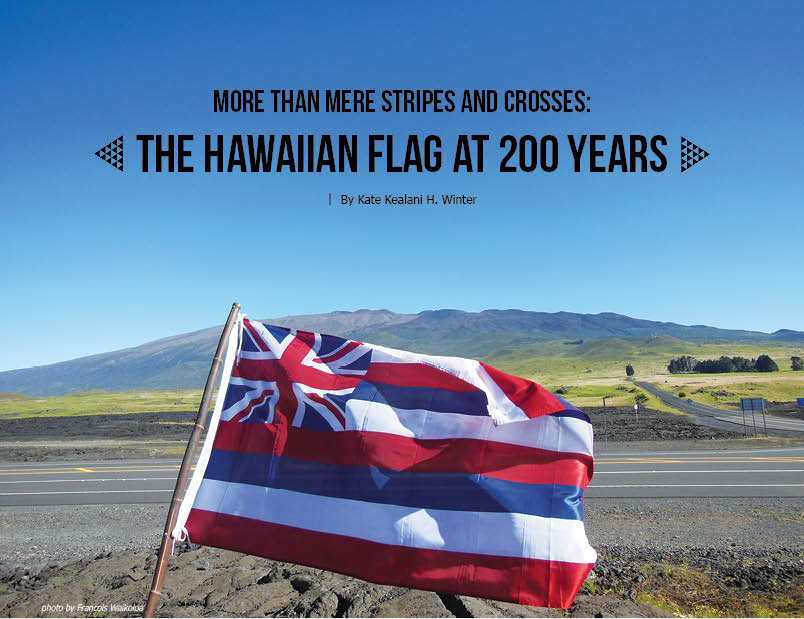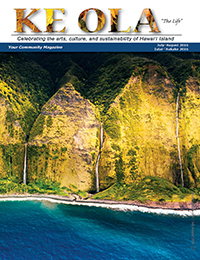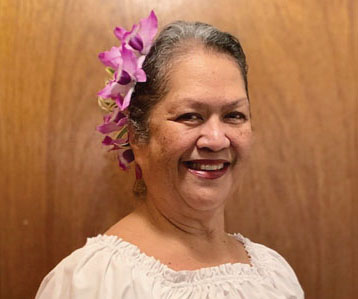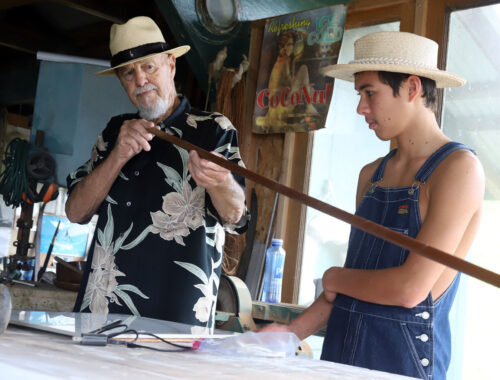
More Than Mere Stripes and Crosses: The Hawaiian Flag at 200 Years
By Kate Kealani H. Winter
From team banners to national pennants, a flag fluttering in a breeze raises intense feelings and inspires loyalty as well as patriotic passions.
This year marks the 200th birthday of the Hawaiian flag, the only flag in America that has been flown to represent a kingdom, a territory, and a state. People in Hawai‘i still recall their kūpuna (elders) describing the day they witnessed the flag of the Hawaiian kingdom being lowered at ‘Iolani Palace in 1893 when Queen Lili‘uokalani was overthrown. Hawai‘i’s official flag remains iconic, whether it waves from a government halyard or a bamboo pole.
Captain George Vancouver gave Kamehameha the Great a red ensign in 1793. The warrior king was claiming and uniting the islands, and Vancouver noted that the king sometimes flew it in places of honor and ceremony. In February 1794, the king entered into an agreement with Vancouver that the British would not interfere with the island nation’s religion, government, and economy. Sometime later, the monarch began flying the British flag, the Union Jack, as an unofficial flag of the kingdom.

During the War of 1812, an American in Hawai‘i asked the king why he was flying what the questioner referred to as the “enemy flag.” The king reportedly had it lowered and an American flag hoisted on the halyard instead. Then the same issue was raised with the king when a British ship arrived in the port of Honolulu. It seems that advisors to the king urged him to blend the British and American flags to create a distinctive one to represent the kingdom and perhaps to avoid future trouble with two important allies of the kingdom.
In 1816, King Kamehameha the Great ordered a Hawaiian flag to be designed. History says that one of two sea captains helped with the design: Captain Beckley or a British Captain Adams. That first Hawaiian flag had nine stripes arranged red/white/blue from the top down. In the canton (upper left corner), the traditional British crosses of St. Andrew and St. George are combined with white representing the argent (silver) of royalty. It is recorded that in 1816, that flag was flown on the first Hawaiian ship to sail to a foreign country, a vessel bound for China. Logbook entries from foreign ships that stopped in the islands after 1816 make mention of the island nation’s new flag.
As a symbol of sovereign Hawai‘i, that flag flew over the islands until Lord Paulet seized the government in November 1843. All Hawaiian flags were ordered destroyed. By that summer, the British monarch Queen Victoria recognized the Hawaiian Kingdom as an independent and sovereign state and sent Admiral Thomas to restore the symbol of that sovereignty. The Hawaiian flag was ceremoniously raised to wave again. In July, along with the restoration of the flag and all that it meant, King Kamehameha III uttered his proclamation: “Ua mau ke ea o ka ‘āina i ka pono,” the life of the land is perpetuated in righteousness. A Hawaiian flag with a dove and olive branch was raised that day.
With many of the old flags hidden or destroyed and some variants appearing, it appears that King Kamehameha III and Captain Hunt of the British ship Baselisk collaborated in the design of a new standard two years later, in 1845. Despite the impulse to assign symbolic meanings to colors, the choice of white/red/blue stripes probably just shows the influence of the national flags flown by the many foreign vessels that visited Hawai‘i in the early years. The number of stripes was standardized at eight to represent the inhabited islands under dominion of the Hawaiian monarchy. That design was unfurled at the opening of the Legislative Council in May 1845. Thereafter, the kingdom’s flag had the white stripe at the top and the pattern white/red/blue was the official one.
The second time that the flag of Hawai‘i was lowered over the kingdom and replaced by another nation’s pennant was at the overthrow of Queen Lili‘uokalani on January 17, 1893. The American flag replaced it over ‘Iolani Palace from February to April of that year. With their monarch imprisoned and the flag gone from sight, it was a profoundly sorrowful time in the kingdom.
Yet in that last decade of the century, a traditional 19th century art form taught by the American missionaries became popular. Quilters throughout the islands designed patterns that integrated the Hawaiian flag into bedcovers and hangings known as “Ku‘u Hae Aloha”—my beloved flag. Sometimes the royal coat of arms, crowns, and other symbols of royalty are included, and some bear the words uttered by Kamehameha III in 1844, that enduring sentiment that became the Hawai’i state motto: Ua mau ke ea o ka ‘āina i ka pono.
Flag quilts were gifted and inherited, rarely used on a bed to avoid soil and wear, and can still be found lovingly preserved in scented chests, museums, and even now on the racks of modern quilters. Like the Hawaiians who took hula underground when missionary sensibility banned it, Hawaiian women (and men) have kept Hawai‘i’s symbolic past safe, celebrated, and current.
In 1894, Hawai‘i was proclaimed a republic under its former sovereign flag. Only four years later, the republic became a US territory and the old flag was retained as emblem. Again in 1959, it remained flying, as the islands became a state.
The deep significance of a flag to the people it represents is evident in the conversations about Hawai‘i’s flag that began in the 1990s Hawaiian renaissance. Some Hawaiians see the flag as a reminder that their heritage was co-opted by western business interests. It is, for them, a woeful symbol of loss.
Some propose the green, red and yellow Kanaka Maoli flag, also known as the native Hawaiian flag. This flag contains a shield bearing a coat of arms, which include a kahili, the original Hawaiian royal standard, and two paddles, meant to represent the voyaging tradition of the Native Hawaiians.
Other people choose and cherish the official Hawaiian flag because it was created by their great king, the unifier of the original Hawaiian nation, King Kamehameha the Great. ❖
Did you know Pu‘ukoholā Heiau is one of only three places where the Hawaiian flag can fly as a symbol of the Kingdom of Hawai‘i?
In observance of the Bicentennial Anniversary of the Hawaiian Flag—Ka Hae Hawai‘i, a special observance and presentation will be held at Pu‘ukoholā Heiau on July 29, 2016, 9am–noon.
Contact Pu‘ukoholā Heiau: 808.882.7218
Contact writer Kate Kealani H. Winter



